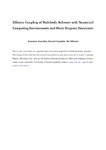Mostrar o rexistro simple do ítem
Efficient coupling of multibody software with numerical computing environments and block diagram simulators
| dc.contributor.author | González Varela, Francisco Javier | |
| dc.contributor.author | González, Manuel | |
| dc.contributor.author | Mikkola, Aki | |
| dc.date.accessioned | 2024-01-12T14:58:13Z | |
| dc.date.available | 2024-01-12T14:58:13Z | |
| dc.date.issued | 2010-03-27 | |
| dc.identifier.citation | González, F., González, M. & Mikkola, A. Efficient coupling of multibody software with numerical computing environments and block diagram simulators. Multibody Syst Dyn 24, 237–253 (2010). https://doi.org/10.1007/s11044-010-9199-6 | es_ES |
| dc.identifier.issn | 1573-272X | |
| dc.identifier.uri | http://hdl.handle.net/2183/34884 | |
| dc.description | This is a post-peer-review, pre-copyedit version of an article published in Multibody System Dynamics. This version of the article has been accepted for publication, after peer review and is subject to Springer Nature’s AM terms of use, but is not the Version of Record and does not reflect post-acceptance improvements, or any corrections. The Version of Record is available online at: http://dx.doi.org/10.1007/s11044-010-9199-6. | es_ES |
| dc.description.abstract | [Abstract] Simulation of complex mechatronic systems like an automobile, involving mechanical components as well as actuators and active electronic control devices, can be accomplished by combining tools that deal with the simulation of the different subsystems. In this sense, it is often desirable to couple a multibody simulation software (for the mechanical simulation) with external numerical computing environments and block diagram simulators (for the modelling and simulation of non-mechanical components). In this work, an in-house developed C++ MBS simulation software has been coupled with the commercial tools MATLAB and Simulink, and different coupling techniques have been identified, implemented and tested in order to assess their computational performance. Two categories of coupling techniques have been investigated: those in which only one tool per-forms the integration (function evaluation) and those in which each tool uses its own integrator (co-simulation). Furthermore, the efficiency of the described coupling methods has been compared to that of equivalent monolithic models, and indications are provided to im-plement them in other simulation environments. Results show that state-of-the-art coupling techniques can reduce simulation times in one or two orders of magnitude with respect to standard techniques. Finally, advices are provided to select the coupling method best suited to a particular application, as a function of its efficiency and implementation effort. | es_ES |
| dc.description.sponsorship | This research has been sponsored by the Spanish MEC, through the F.P.U. Ph.D. fellowship No. AP2005-4448. | es_ES |
| dc.language.iso | eng | es_ES |
| dc.publisher | Springer | es_ES |
| dc.relation | info:eu-repo/grantAgreement/MEC/Plan Nacional de I+D+i 2004-2007/AP2005-4448/ES | es_ES |
| dc.relation.uri | https://doi.org/10.1007/s11044-010-9199-6 | es_ES |
| dc.subject | Multibody | es_ES |
| dc.subject | Multiphysics | es_ES |
| dc.subject | Co-simulation | es_ES |
| dc.subject | Coupling | es_ES |
| dc.subject | Efficiency | es_ES |
| dc.subject | Block diagram simulators | es_ES |
| dc.subject | Multicuerpo | es_ES |
| dc.subject | Multifísica | es_ES |
| dc.subject | Co-simulación | es_ES |
| dc.subject | Acoplamiento | es_ES |
| dc.subject | Eficiencia | es_ES |
| dc.subject | Simuladores de diagramas de bloques | es_ES |
| dc.title | Efficient coupling of multibody software with numerical computing environments and block diagram simulators | es_ES |
| dc.type | info:eu-repo/semantics/article | es_ES |
| dc.rights.access | info:eu-repo/semantics/openAccess | es_ES |
| UDC.journalTitle | Multibody System Dynamics | es_ES |
| UDC.volume | 24 | es_ES |
| UDC.startPage | 237 | es_ES |
| UDC.endPage | 253 | es_ES |
| dc.identifier.doi | https://doi.org/10.1007/s11044-010-9199-6 |
Ficheiros no ítem
Este ítem aparece na(s) seguinte(s) colección(s)
-
LIM - Artigos [52]






